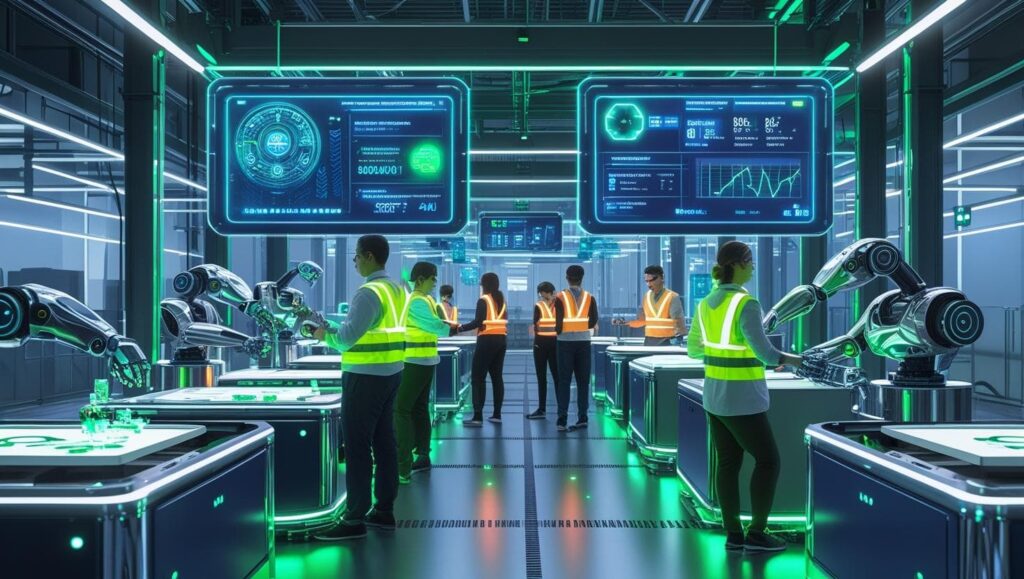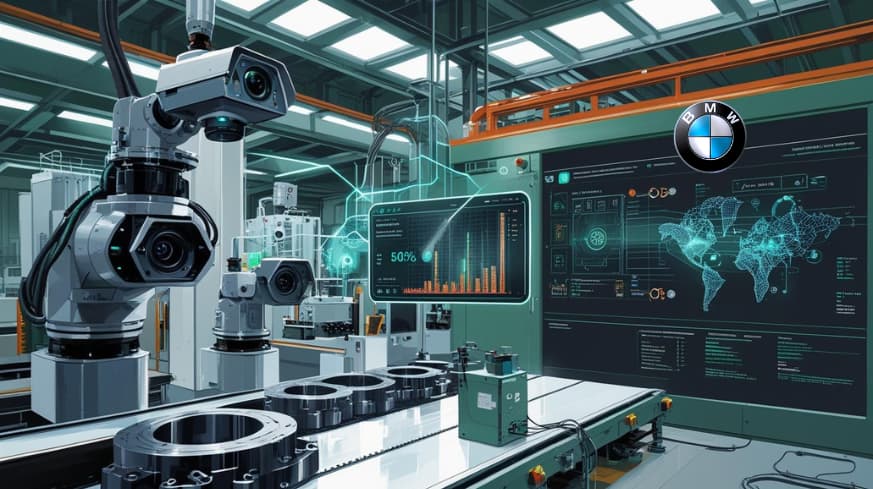

Today, factories are smarter than they were before. Machines are not only working but they also are thinking and improving. All of this is made possible because of artificial intelligence. AI gives factories across the world the ability to work faster and safer.
But how is this possible? What are the benefits of AI in the manufacturing industry, and how do they help industries grow?
This blog will explain everything in simple terms. We will explore the main reasons AI is in factories, how it helps workers, and how companies can grow using AI tools. If you are interested in learning about the future of manufacturing, this is an excellent place to start.
Let’s learn more about AI benefits in manufacturing in the current and future world!
AI is a smart system created by humans, and it can think like a brain. It uses data and information to learn and make proper decisions. AI helps machines and workers work in factories.
AI can, for example:
So, when we talk about the benefits of AI in manufacturing, we are talking about how these smart tools help factories grow and improve.

Factories are always trying to do more in less time. They want to:
AI contributes to all of these objectives. It provides intelligence advice and assists factories in their processes efficiently. This means less waste, more wins, and better success in business.
Now let us discuss the primary advantages of AI in manufacturing and how that occurs in real time.
A major advantage of using AI technology is to inspect product quality. In the past, workers had to manually inspect every item for quality and intricate mistakes. This inspection process was very labor and time intensive, and sometimes mistakes could be undetected when checking manually.
Today, with AI technology which utilizes highly intelligent cameras and tools, they can detect even the smallest defect. It can provide real-time feedback on the products. If the product has a crack, wrong color or missing component, AI can detect this within seconds.
This means fewer mistakes are sent to customers and continually maintaining a favorable reputation.
Machines are a critical part of most factories. However, they do sometimes fail without notice, which is a cost and delay.
Artificial intelligence can help avoid this situation by listening to the machine and obtaining data like noise, speed, and heat. When any of these metrics indicate a problem, AI can issue a notice before the machine fails.
This is called predictive maintenance. It allows the unresolved problem to be found early to avoid time and money lost in the long run.
AI can also assist with scheduling since it can monitor how long each job takes, which machines may be available, and the workforce needs.
AI will help generate solid ideas to assist your work to move along quicker, an example would be called smart scheduling or workflow planning.
We have seen that factories using AI in their planning have spent less time waiting and more time working.
Factories use large amounts of electricity, water and other resources. There can be instances of wasting these resources without the human operator even being aware of it.
AI can monitor use of the energy and see places the energy is left running. It can point out how to reduce “idle time” by telling you to turn off a queried machine or run it at a better time.
This can produce good savings and be good for the environment.
AI can help with worker safety. It can look for unsafe actions or even inform supervisors when something dangerous is going to happen.
For example:
Overall, these systems will make factories safer and mitigate accidents.
Producing the right quantity of products and having the proper quantity of material is very important. If a factory produces too many, there is waste. If a factory produces too few, customers have to wait.
AI is able to look at sales data, customer orders, and even the weather. It will then inform the factory how much to produce and when to replenish things.
This will help keep everything balanced and operating smoothly.
Some consumers want customized products to meet their special needs. Historically, this has not been easy, nor has it been quick. AI allows you to make custom changes to the product without stopping an entire production system.
Whether adding a name, changing colors, or using alternate materials, with AI, it is a matter of clicking some buttons; the customizations are easy and fast! This creates happy customers while increasing sales for the factory!
Product design takes time. In the past, engineers would sketch and build countless designs and test them all and choose one. AI makes this work easier.
AI applies data from past designs; it tests design ideas using simulations and helps engineers determine the best size or shape. The AI will also help select which of the materials would fit better.
This creates a faster development cycle and eliminates trial and error.
Factories collect massive amounts of data daily—machine speeds and many other metrics. A majority of this data is left unused.
AI can access the data and convert it into meaningful information. It identifies what is going wrong, what is going right, and opportunities for improvement. This assists factory managers in making better decisions.
AI brings better quality, reduced waste, and more speed, and all this leads to one big thing: more profit. When a factory can work smarter, it slows down spending and increases earnings.
As this progresses, this will allow the business to grow or test ideas. That is why the benefits of AI in manufacturing are not just about hardware and small improvements; it’s about real growth in business.

There are many large corporations utilizing AI now; here are a few examples:
These are examples that show that AI is not just an idea; it is improving manufacturing as we speak.
You don’t have to be a technology wizard to start using AI tools. Here is a straightforward way to get started:
Step 1: Choose One Problem: Keep it simple. Choose one problem to concentrate on, like machine downtime or slow planning, to begin with.
Step 2: Gather Your Data: Record numbers and archive historical reports. Since AI uses data to learn, it is important to depend upon various datasets to provide an accurate and diverse learning pool.
Step 3: Select an AI Tool: There are some ready-made tools that offer AI features. You can also have consultants like WebOsmotic create a technology solution to problems particular to your factory.
Step 4: Implement and Learn: Implement AI into a small part of your work, and review the impact. Draw learnings as you progress, and grow from it.
Step 5: Educate Your Team: Help your team to learn how to use AI. Workers will apply tools and software better when they are educated.
At WebOsmotic, we help companies use AI in simple ways. It could be anything from checking the quality of your products to better planning; we provide tools the way you need them.
We are not just selling you software. We come alongside your team and help you one step at a time. We believe the best way to help your factory grow is through smart tools.
Regardless of the size of your business, AI has something for you, and WebOsmotic is here to help.
As a reminder, AI is a no brainer in manufacturing. It saves factories time and helps factories produce better products and grow faster. It improves the safety of factories, saves money, and keeps customers happy.
AI is not just for the big factories. Small and mid-size factories can also benefit from AI. You only need an effective partner, good data and a small action.
If you want a smarter factory, WebOsmotic is ready to help you.
Let’s build a better future together.